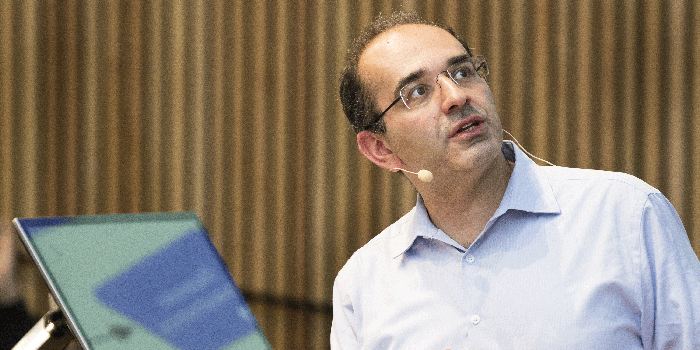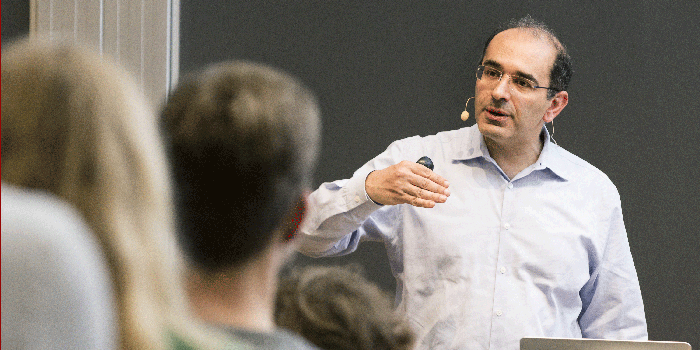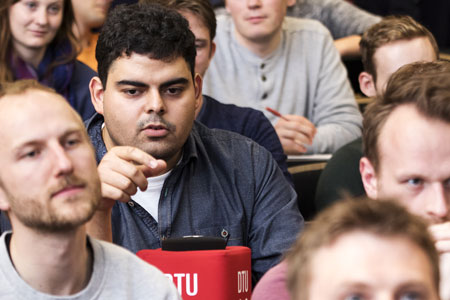Used properly, artificial intelligence will be a tool in creating a more just society, according to Machine Learning pioneer Zoubin Ghahramani.
Much has been said on Artificial Intelligence (AI). Zoubin Ghahramani has not limited himself to numerous theoretical contributions, but also engaged in practical solutions—the latest being an automated statistician.
“After a mathematical processing of the data presented to it, the machine will summarize the results in the same way a human statistician would. The report is of value to someone who is a skilled professional in a given field without being a statistician himself. An example could be a medical doctor due to diagnose a patient on the basis of data from imaging or tissue samples,” Zoubin Ghahramani explains.
“This software will not put human statisticians out of work. However, several tasks within statistics are more suited for machines than for humans. Humans are actually not very good at doing things systematically.”
Machine learning is all around
Iranian born Zoubin Ghahramani is a professor at the University of Cambridge, UK. Following his double degree in Cognitive Science and Computer Science from the University of Pennsylvania, USA, he wrote his PhD thesis at MIT on “Computation and Psychophysics of Sensorimotor Integration”. He has worked in Machine Learning since.
“Machine Learning is all around. As I land here in Copenhagen, I am able to find my way immediately thanks to my smartphone. And when I receive an email in a foreign language, translation software allows me to grasp the content. These applications depend on invisible algorithms developed within our field.”
Other examples are voice recognition, image recognition, speech recognition, automated financial trading, automated cars and robots, and recommender systems that supply users with names of restaurants and stores to suit their personal taste.
When machines discriminate
Such solutions have come to stay, but Zoubin Ghahramani acknowledges that Machine Learning has potential downsides.
“A system for support on criminal parole decisions was tried in USA. The idea was that decisions could be taken both faster and more just when based upon a set of objective parameters. However, as the system was evaluated a clear bias became clear. The system would grant white inmates much better chances of parole than it would other prisoners.”
A similar example is equal opportunities for both genders.
“Say I am to engineer a system able to shortlist job applicants. A natural ambition—often supported by government regulation - will be to secure equal opportunities for male and female applicants. Obviously, I can instruct my algorithm to exclude the information of the sex of the applicant. However, it would be naïve to assume this will solve my task. Men and women tend to choose to put different types of information in their applications, and therefore it is actually a highly complex challenge to ensure that both genders are truly given equal opportunities.”
This all goes to show that creators may easily feed their own moral and cultural values into a Machine Learning solution.

“Most often this happens unintentionally. A tiny nuance in wording may create a bias,” Zoubin Ghahramani states. “But the good news here is, that if we manage to get things right, our society can become significantly more just. I think we all know very well, that humans are not at all objective when they decide on which applicants to interview for a vacant position, or which prisoners to grant parole. A machine will be able to make these decisions far more objectively. This fundamentally makes me highly optimistic!”
The term "Machine Learning"
"As I see it, the interesting thing is not so much what intelligence is, but rather what it does. "
Zoubin Ghahramani, professor at Cambridge University.
So, in other words a machine can be trained to outperform humans when it comes to making decisions?
“Well, I do know this claim will be a bit controversial to many! But please note that I am not suggesting machines to be wiser than humans. Intelligence is not this one thing. As I see it, the interesting thing is not so much what intelligence is, but rather what it does. When you take a functional approach, you will see that machines are best suited for some tasks, humans for others—and in some cases animals do better. I see this as the constructive approach.”
As a consequence of this approach, Zoubin Ghahramani generally prefers the term “Machine Learning”.
“The term “Artificial Intelligence” tends to trigger very different associations in different people. You can avoid that by talking about Machine Learning. Actually, the difference is mostly in time horizon. To my understanding, artificial intelligence denotes machines carrying out tasks previously done by humans, in a fully automated way. This remains futuristic. As for Machine Learning, humans are still involved, supporting the machines in finding solutions. This is also a thing of the future, but not that far ahead. The majority of the applications we see today can be categorized under a third field, namely Data Science. Here, machines do quite much. Like collecting and sorting huge amounts of data. But humans make the decisions.”

Artificial Intelligence, Machine Learning and Data Science also represent three different traditions in research.
“The fields overleap in their content but have been organized as three different research communities. I clearly identify myself as part of the Machine Learning community.”
Transparency is key
Currently the field of Machine Learning is undergoing a change in focus.
“Originally, it was all about accuracy. Who was able to create algorithms allowing the machine to solve its tasks with the highest degree of accuracy? Later came the demand for algorithms which were also efficient. We realized that we had to minimize the need for computing power both in order to cut costs and energy consumption. For example, search engines account for energy consumption on a massive scale these days. Obviously, both accuracy and efficiency remain important but a third requirement has emerged. Namely, how unfortunate side effects of Machine Learning can be mitigated—such as humans being treated unfairly, or having their privacy invaded.”
Zoubin Ghahramani sees transparency as the answer:

“Every time you introduce a new Machine Learning solution, you need to show openly which algorithms it is based upon. In this way others may evaluate whether the system could involve unintentional bias. Have such bias corrected for will be in everybody’s best interest,” Zoubin Ghahramani reasons. He gives an example to support his point:
“Credit decisions by banks and other financial institutions are generally well suited for systems based on Machine Learning. But one has to remember, that such decisions may impact the living conditions of the loan applicant strongly. The system needs to tell openly why a loan application was denied. Without this openness, the suspicion of some kind of discrimination will always linger.”
The occasion for the interview is an DTU Ørsted lecture by Zoubin Ghahramani at DTU on 24 April 2017. He also visited the Machine Learning community at DTU.
“I’d rather not name specific groups or researchers as others might feel left out, but just state that the Machine Learning community at DTU is world class. Still, DTU suffers from the same problem we all have—recruiting of experts in this field is challenging. Each time you have a vacant position you are not only competing against other universities, but also large corporations able to pay high salaries.”
Zoubin Ghahramani is a Royal Society member and was recently co-author of an academy report on Machine Learning. A key recommendation in the report is a large increase in the number of candidates in the field.
“As documented in our report, Machine Learning carries a large potential for societal and economic growth. One of the most rewarding features of working in this field is how a clever solution to a given problem may find applications in a diversity of fields. Having succeeded in creating an automated statistician, for instance, we have good chances of applying the same algorithms for identifying cancer cells in a tissue sample or helping astronomers charting the universe.”
The automated statistician is a software product in its own right, but was also a research project, Zoubin Ghahramani explains:
“During a project of this nature, one is bound to meet several obstacles. Several of these prove to be systematic, meaning the solutions to them can be applied to other Machine Learning projects.”
On the road to super humans...
The first barrier for Machine Learning is common conventionalism:
“Developing new efficient algorithms is one thing, convincing people to make use of them is quite another. The simpler algorithms you come up with, the better your chances as people like to understand what they are dealing with. Also, you need to provide your solution for free or very cheaply.”
A further barrier can be lack of the real-life data needed for verification of the new algorithms.
“Data are fuel for Machine Learning. The field has developed immensely over the last few decades. While some of this progress can be credited to better algorithms, I would actually argue that even more credit should go to the much higher availability of data. However, in some contexts we still have difficulty in finding the data we need.”
Still, Zoubin Ghahramani remains convinced that the field of Machine Learning will continue to evolve at an even larger pace:
“It is sometimes argued that Machine Learning will turn us into super humans. I tend to agree, but are we in fact not super humans already in comparison to our ancestors? Through the latest generations mankind has obtained a range of new tools. I see Machine Learning as a part of that trend. The machine may be learning, but it only does so in order to become an even better tool for humans.”
Hans Christian Ørsted (1777-1851) was a major force behind the establishment of the College of Advanced Technology (now DTU) in 1829, where he served as the first director until his death in 1851. He is one of the best-known Danish scientists, due to his discovery of electromagnetism in 1820. He was also responsible for the introduction of Danish equivalents for words such as hydrogen, oxygen, volume, and firebrand.
DTU’s mission of ‘developing and creating value using the natural and technical sciences to benefit society’ has roots going back to H.C.Ørsted and the committee responsible for establishing DTU. The provisional plan for establishment states:
“The aim of the College of Advanced Technology is to give young people with the necessary qualifications such insight into mathematics and empirical science, and such skills in the application of these insights, that they can be useful in certain branches of government service and be responsible for industrial plants.”
More about DTU’s history.